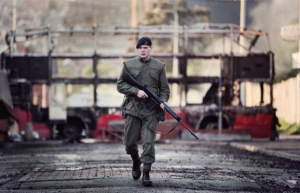As Pvt. Gary Hook prepares to be deployed to Northern Ireland at the beginning of the film “‘71,” he is reassured by his British army superior that he should not worry, as he is not even leaving the country—and therein lies the conflict.
“‘71” is a historical action film set in its titular year about the Troubles in Northern Ireland. A riveting story of lost innocence and treachery, multilayered betrayal, and harrowing chase scenes, “‘71” is an insightful nailbiter.
The film is, at its essence, a giant manhunt.

Hook finds himself cut off from his fellow troops and left behind in a crowd-control operation in Belfast that quickly devolves into a violent riot. His mission is to survive the night—wounded, terrified, disoriented, and alone—in tumultuous Northern Ireland. He quickly learns that no place is safe, that any place can be a war zone, and that he can trust no one.
Jack O’Connell, who recently starred in “Unbroken,” does a phenomenal job capturing Hook’s bewilderment and fear. Hook isn’t a classic “tough guy” soldier, but it’s O’Connell’s youthful charisma and raw emotion that define the film. He doesn’t have many lines—there’s little dialogue in the film overall—but what’s there is powerful and artfully delivered.
The film, which premiered at the Berlin Film Festival in Feb. 2014 and was widely released in the U.K. in the fall, assumes that its viewers are familiar with Northern Ireland’s past. The average American may want to read up on European history before watching, but O’Connell’s performance is worthwhile to see regardless of knowing historical context.
The film is set in a particularly violent time during the Troubles, a term used to describe the decades-long 20th century conflict between the United Kingdom and Ireland, is politically complicated. England and Ireland have a difficult history, with conflicts beginning centuries ago, and the Troubles ended in just 1998—after many Redwood students were born.
It’s estimated that more than 3,500 people were killed in the conflict, including almost 2,000 civilians, and more than 47,000 were injured. The film introduces viewers to many warring factions on both sides, from the Irish Republican Army (IRA) and the Provisional IRA to the Ulster Defence Force and the British army’s Military Reaction Force. No member of these violent groups ends the film squeaky-clean; they are shown to be traitorous, brutish terrorists.
Though most of the scenes in the film range from horrifying to even more horrifying, the less stressful moments are also well done.
Hook becomes likeable right off the bat, as the audience is introduced to his orphan little brother and sees the two play before Hook leaves for Belfast. The audience later sees a young member of the provisional IRA return home to a mother and little sister, in jarring contrast to the night he just spent hunting for the soldier.
These human moments clash with the shocking violence and show how the war was fought between neighbors of all ages, on city streets, in pubs, and in homes.
Directed by the French-born, London-raised Yann Demange, the movie manages to tell the story from the perspective of one British soldier without picking sides.
As a Catholic Irish-American, I entered the film biased toward the republican Irish and against the mostly Protestant Northern Irish and British. Though I didn’t enter the theater as an IRA sympathizer and definitely didn’t leave pro-imperialism, I walked out with sympathy for both sides.
Demange’s feature debut is daring. The film is not for the squeamish; there’s a lot of gore and realistic depictions of explosions and fighting, and the movie easily deserves its R rating. As the movie is shot mostly with a handheld camera, the audience is thrust to the center of the action. It’s gritty, raw, and exhausting.
“‘71,” which was widely released in the United States on March 13, is unlikely to be a blockbuster—it is playing in just one theater in Marin, the Century Regency in San Rafael—but the twelve other people in the theater and I know that it is one of the best films we’ve seen in a long time.

















